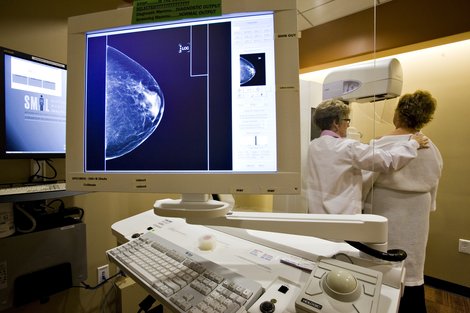More than likely, you or someone you know has been affected by breast cancer at some point in their lives. It is the most common form of cancer among women in the United States. However, if detected early, there is a 98 percent chance of survival.
Recognized by The American College of Radiology as Breast Imaging Centers of Excellence, Scottsdale Medical Imaging, Ltd. has been, and continues to be, on the leading-edge of researching and implementing state-of-the-art imaging technology combined with subspecialized and fellowship-trained breast imaging radiologists to provide women the highest level of expertise in breast cancer detection.
SMIL offers the most innovative imaging technology available, including new 3-D digital mammography, breast MRI, minimally invasive breast biopsies, and the innovative PEM (Positron Emission Mammography).

3-D Digital Mammography
Beginning in September, SMIL will be one of the first healthcare providers in the nation to offer breast tomosynthesis, otherwise known as 3-D mammography, the latest advance in breast cancer screening. 3-D imaging allows radiologists to see through dense and overlapping tissue in the breast, sometimes a limiting factor on regular 2-D mammograms. Early clinical trials of this promising new FDA-approved technology suggest increased cancer detection rates and a reduction in the number of false positive results.
When a patient requests a 3-D mammogram, the experience is similar to the current standard of care 2-D digital mammogram in terms of compression and positioning. The mammogram camera rotates over the breast in an arc obtaining both the 2-D images as well as 3-D information.
SMIL is proud to have been involved in the pre-FDA national research trials and was the only medical imaging provider in Arizona to be using this technology for research two years prior to the FDA’s approval in February 2011. As a result, SMIL’s team of eight breast tomosynthesis radiologists have a combined 16-year body of experience. SMIL is continuing to research this technology to provide cutting-edge, yet data-driven care by partnering with academic medical centers across the country to scientifically validate the efficacy of this new technology. Discuss with your doctor if a 3-D mammogram is right for you.
MRI
In conjunction with mammography, breast MRI is utilized for patients at high-risk for breast cancer (i.e., strong family history of breast cancer or known BRCA gene). In fact, breast MRI has been proven to reduce mortality (death rates from breast cancer) in these patients. MRI is so exquisitely sensitive at detecting subtle changes that radiologists are now finding cancer earlier than they have ever been able to find it before.
